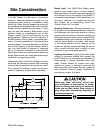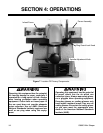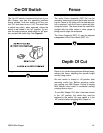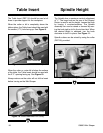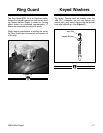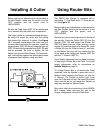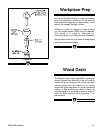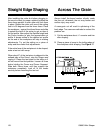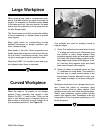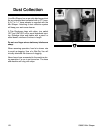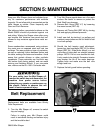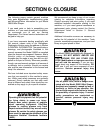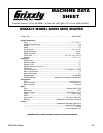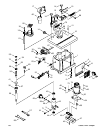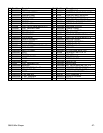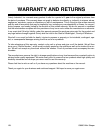
G8693 Mini Shaper -21-
When shaping long, wide or cumbersome work-
pieces, the table may be too small to provide full
support. An extension for the table can be added
to the sides and front. Use only smooth, flat wood
and be sure the extension is on the same level as
the Mini Shaper table.
The Fence faces are drilled to allow the addition
of fence extensions or wooden faces to provide
more support.
Many good books on woodworking provide
detailed instructions on shaper operation, pat-
terns, fixtures and jigs.
Keep hands in the clear. Never jeopardize your
hands; keep them at least six inches from the cut-
ter at all times. If workpiece is small, use a hold-
ing jig of some type to guide it past the cutter.
Ring Guard (REF 19) should be used and prop-
erly adjusted when fence is removed.
Large Workpiece
When the edge to be shaped is not straight,
remove Fence assembly and replace it with
Radius Pin (REF 11) and a collar. Collar can be
solid or ball bearing and is mounted above or
below cutter on stub shaft to set the depth of cut
(see accessories section). See Figure 18.
Curved Workpiece
Figure 18.
Two methods are used for shaping curved or
irregular edges:
1. Collar-This method can be used when at least
1
⁄
8'' of edge will remain uncut. Workpiece is cut
and sanded to exact shape desired. Rest
workpiece against radius pin and feed straight
into cutter until finished edge is against collar.
Keep edge being shaped at 90 degrees to col-
lar. Hold part firmly against collar and slowly
feed around shape until complete.
2. Pattern-A pattern or template can be cut from
1
⁄
4'' hardboard or scrap wood. This method is
the best way to make several pieces of the
same shape. Allow for diameter of collar, con-
tour shape and depth of cut when cutting pat-
tern.
Workpiece should be cut to a shape close to pat-
tern. Fasten the pattern to workpiece using
clamps, screws, brads or rubber cement. Feed
workpiece into cutter until collar contacts pattern.
Slowly feed workpiece around pattern holding
pattern tight against collar. Remember to do any
cross grain cut first to prevent splintering on fin-
ished workpiece.



